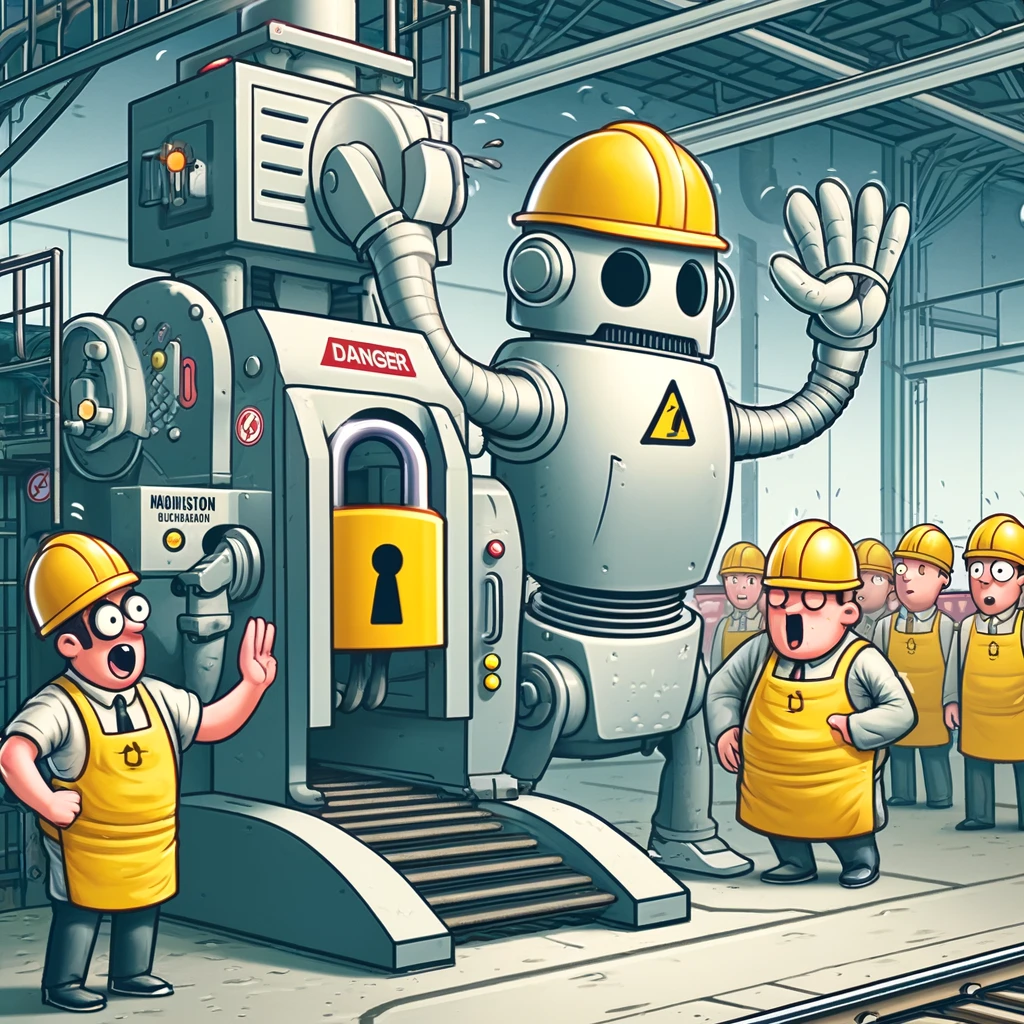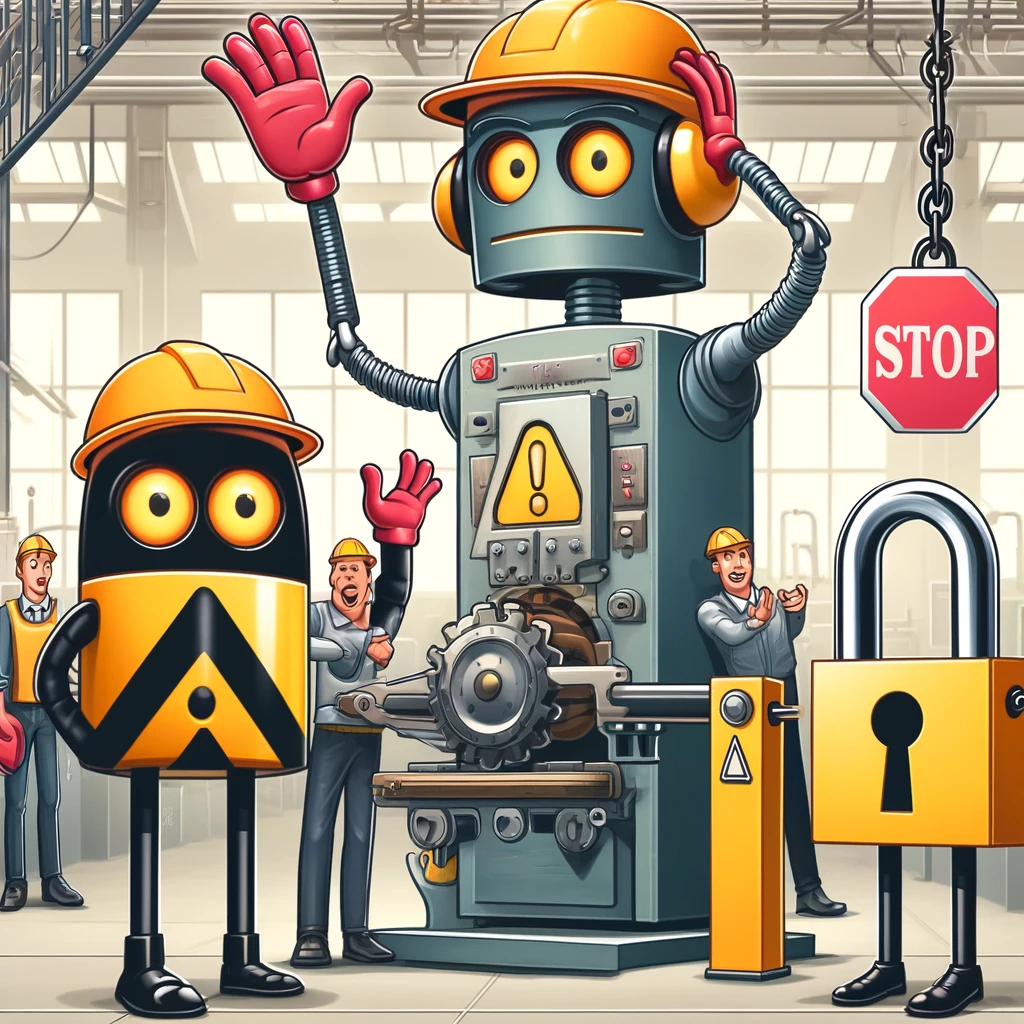In today’s industrial landscape, particularly within industrial automation, the emphasis on workplace safety has never been greater. A pivotal component in ensuring this safety is the implementation of machine guards. These guards adhere to numerous harmonized standards and regulations, such as the Machinery Directive 2006/42/EC and the Machinery Regulation 2023/1230. Introducing appropriate guards is also crucial in the CE certification process, confirming that a machine meets all safety requirements.
Table of Contents
Machine Guards in Industrial Automation

Industrial automation demands technologically advanced solutions, including effective machine guards. These guards must comply with harmonized standards to ensure the protection of operators and equipment. Compliance with the Machinery Directive 2006/42/EC is essential for the legal operation of machinery in Europe. In industrial automation, machine guards serve as the first line of defense against mechanical, chemical, and physical hazards that may occur during machine operation.
Types of Machine Guards According to PN-EN ISO 14120
The PN-EN ISO 14120 standard defines various types of machine guards that can be applied depending on specific needs and hazards. Below are the most important types:
Fixed Guards
Fixed guards are permanently attached to the machine and can only be removed using tools. They are most commonly used where access to danger zones is rarely required. These guards provide high durability and resistance to damage, which is crucial in industrial environments.
Movable Guards
Movable guards can be opened and closed without tools. They are equipped with interlocking systems that prevent the machine from operating when the guard is open. They are used where regular access to danger zones is required, such as during maintenance or repairs. These guards offer ease of access while maintaining a high level of safety.
Adjustable Guards
Adjustable guards can be modified according to the size and shape of the material being processed. They provide a minimal opening through which the material can pass while protecting against access to danger zones. These guards are particularly useful in production processes where material parameters frequently change.
Monitored Guards
Monitored guards are equipped with monitoring systems that check the status of the guards and prevent the machine from operating when the guard is improperly set. They are used in the most critical applications where safety is paramount, such as in heavy industry, FMCG, or automotive sectors.
Table: Types of Machine Guards and Their Applications
| Type of Guard | Description | Application |
|---|---|---|
| Fixed Guards | Permanently attached, removable only with tools | Zones with rare access to hazards |
| Movable Guards | Openable without tools, with interlocking systems | Regular access to hazard zones |
| Adjustable Guards | Adjustable to material size and shape | Minimal opening, access to hazard zones |
| Monitored Guards | Monitored interlocking systems | Critical applications, highest safety requirements |
Designing Machine Guards
Design offices play a crucial role in designing machine guards. This process requires precise strength calculations (FEM) to ensure the durability and reliability of the guards. Designing machines in accordance with harmonized standards is essential for obtaining CE certification. Ergonomics must be considered in the design process to ensure that guards are easy to operate and maintain.
The use of modern design tools, such as advanced CAD software and FEM simulations, allows for thorough testing of guards even at the design stage. This helps avoid many potential issues that could arise during machine operation.
CE Certification and Marking
The CE certification process for machines involves assessing the compliance of machine guards with safety requirements. CE marking is proof that a machine meets all applicable regulations and standards, which is crucial for its introduction to the European market. CE certification requires a thorough analysis and testing to confirm that the guards effectively protect against mechanical and other hazards.

The CE mark is not only a symbol of compliance with regulations but also a testament to quality and safety. It assures machine users that the product meets the highest safety standards. The certification process includes both the evaluation of technical documentation and practical tests that confirm the effectiveness of the guards in various working conditions.
Safety Audits and Risk Analysis
Regular safety audits and risk analysis according to PN-EN ISO 12100:2012 are essential for evaluating the effectiveness of machine guards. Safety audits identify potential hazards and implement corrective measures, enhancing workplace safety. Risk analysis assesses all possible hazards that may occur during machine operation and determines actions to minimize them.
During a safety audit, detailed inspections of all machine components, including guards, are conducted. Auditors check whether guards are properly installed, undamaged, and meet all harmonized standards. Regular audits are crucial for maintaining a high level of safety over the long-term operation of machines.
Adapting Machines to Minimum Requirements
Adapting machines to minimum requirements involves implementing appropriate guards that meet safety standards. Examples include installing fixed and movable guards that prevent access to danger zones. It is important that all guards comply with current standards and regulations, ensuring their effectiveness.
Adapting machines to minimum requirements often involves modernizing existing equipment. These actions may include introducing new guards, more advanced monitoring systems, and additional mechanical protections. All these measures aim to enhance safety and protect workers.
Harmonized Standards and Machinery Regulation 2023/1230
Harmonized standards define technical requirements for machine guards, ensuring their compliance with European regulations. New regulations introduced by the Machinery Regulation 2023/1230 raise safety standards by introducing additional requirements for guards. Implementing these standards and regulations is crucial for ensuring machines’ compliance with legal requirements.
Harmonized standards cover a wide range of technical aspects, from materials used in guard production, through installation methods, to detailed requirements for strength tests. Adhering to these standards is not only mandatory but also beneficial for manufacturers who can offer products of the highest quality.
Project Management and Engineer Outsourcing
Effective project management is crucial for implementing machine guards in the industry. Outsourcing engineers specializing in the design and implementation of guards can significantly accelerate this process, ensuring high quality and compliance with standards. Project management includes planning, monitoring progress, and quality control at every stage of project execution.
Outsourcing engineers allows companies to leverage the knowledge and experience of specialists who possess the necessary skills and tools to design advanced protective systems. This enables businesses to focus on their core activities while ensuring that the design and implementation of machine guards are carried out to the highest standard.
Machine Guards: Conclusion
Machine guards are an indispensable element of safety in the industry. Through appropriate design, certification, and regular safety audits, operators and equipment can be effectively protected from mechanical hazards. The future of machine guards involves further technological development and increasing safety standards, contributing to even greater protection in industrial environments.
The introduction of advanced monitoring systems, innovative materials, and new technologies in the design of machine guards are directions in which the industry will develop. The application of these modern solutions will allow for even more effective safeguarding of danger zones, resulting in increased safety and work efficiency in various industrial sectors.
FAQ: Machine Guards
Machine guards are physical barriers that protect operators from accessing danger zones and from ejected parts and other mechanical effects.
Machine guards enhance workplace safety by minimizing the risk of accidents and injuries. They are crucial for compliance with occupational health and safety regulations and harmonized standards.
There are fixed, movable, adjustable, and monitored guards. Each type has its specific application depending on safety and operational requirements.
Fixed guards are used where access to danger zones is rarely required and where durability and resistance to damage are crucial.
Movable guards can be opened without tools and are used where regular access to danger zones is required, such as during maintenance.
The PN-EN ISO 14120:2016 standard outlines general requirements for the design, construction, and selection of fixed and movable guards, ensuring their effectiveness and safety.
CE certification for machines confirms that a machine meets all European safety requirements. CE marking is essential for legally introducing machines to the market.
A safety audit involves assessing all machine components, including guards, to identify potential hazards and implement corrective measures.
Risk analysis according to PN-EN ISO 12100:2012 is the process of assessing and identifying hazards associated with machine use and determining actions to minimize these hazards.
Yes, outsourcing engineers specializing in machine guard design can expedite the implementation process and ensure high quality and compliance with standards.
